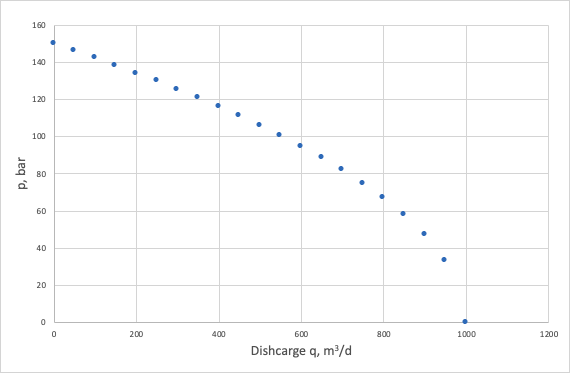The most general Pump model is given as a function of the mass flowrate on the intake
| LaTeX Math Inline |
|---|
| body | --uriencoded--p_%7B\rm in%7D |
|---|
|
and discharge pressure
| LaTeX Math Inline |
|---|
| body | --uriencoded--p_%7B\rm out%7D |
|---|
|
:
| LaTeX Math Block |
|---|
| anchor | pump_m |
|---|
| alignment | left |
|---|
|
\dot m = M(p_{\rm out}, p_{\rm in}) |
It's often presented in terms of intake volumetric flowrate:
| LaTeX Math Block |
|---|
| anchor | pump_q |
|---|
| alignment | left |
|---|
|
q = q_{in} = \frac{\dot m}{\rho(p_{in})} = \frac{M(p_{\rm out}, p_{\rm in})}{\rho(p_{in})} |
where
| fluid density as a function of fluid pressure |
The electrical power consumption
| LaTeX Math Inline |
|---|
| body | --uriencoded--\displaystyle W = \frac%7BdE%7D%7Bdt%7D |
|---|
|
is given by:
| LaTeX Math Block |
|---|
| anchor | eta_pump |
|---|
| alignment | left |
|---|
|
W = \eta(q) \cdot q \cdot (p_{\rm out}-p_{\rm in}) |
where
In most practical cases the pump model
| LaTeX Math Block Reference |
|---|
|
depends on the difference between intake and discharge pressure
| LaTeX Math Inline |
|---|
| body | --uriencoded--p_%7B\rm out%7D - p_%7B\rm in%7D |
|---|
|
and called
Pump Characteristic Curve (see
Fig. 1):
| LaTeX Math Block |
|---|
|
q = q(p_{\rm out} - p_{\rm in}) |
A popular pump proxy model is given by the quadratic equation:
| LaTeX Math Block |
|---|
| anchor | q_pump |
|---|
| alignment | left |
|---|
| q = \frac{q_{\rm max}}{2 \cdot k_f} \cdot \left[ -1 + k_f + \sqrt{ (1 + k_f)^2 - 4 \cdot k_f \cdot (p_{\rm out}- p_{\rm in})/\delta p_{\rm max}) \ } \, \right] |
| | LaTeX Math Block |
|---|
| anchor | q_pump |
|---|
| alignment | left |
|---|
| p_{\rm out} = p_{\rm in} + \delta p_{\rm max} \cdot \left[ 1+
(k_f -1 ) \cdot \frac{q}{q_{\rm max}} - k_f \cdot \left( \frac{q}{q_{\rm max}} \right)^2
\right ] |
|
| LaTeX Math Block |
|---|
|
\eta(q) = 4 \, \eta_{\rm max} \cdot q/q_{\rm max} \cdot ( 1 - q/q_{\rm max}) |
where
| LaTeX Math Inline |
|---|
| body | --uriencoded--\delta p_%7B\rm max%7D |
|---|
|
| maximum pressure gain that pump can exert over the input pressure |
|---|
| maximum flowrate that pump can produce |
|---|
| total hydraulic pump friction (dimensionless) |
|---|
| pump efficiency |
|---|
| maximum pump efficiency |
|---|
Many pumps can be normally adjusted by the variation of the working frequency which affects the maximum pump flowrate and maximum pressure gain as:
| LaTeX Math Block |
|---|
| q_{\rm max} = q^*_{\rm max} \cdot \frac{f}{f^*} |
| | LaTeX Math Block |
|---|
| \delta p_{\rm max} = \delta p^*_{\rm max} \cdot \left( \frac{f}{f^*} \right)^2 |
|
where
| LaTeX Math Inline |
|---|
| body | --uriencoded--q_%7B\rm max%7D |
|---|
|
| maximum intake flowrate at the working frequency | | LaTeX Math Inline |
|---|
| body | --uriencoded--\delta p_%7B\rm max%7D |
|---|
|
| maximum pressure gain at the working frequency | | adjusted working frequency |
| LaTeX Math Inline |
|---|
| body | --uriencoded--q%5e*_%7B\rm max%7D |
|---|
|
| maximum intake flowrate at the nominal frequency | | LaTeX Math Inline |
|---|
| body | --uriencoded--\delta p%5e*_%7B\rm max%7D |
|---|
|
| maximum pressure gain at the nominal frequency | | nominal frequency |
See also
Natural Science / Engineering / Device / Pump
Physics / Fluid Dynamics / Pipe Flow Dynamics / Pipe Flow Simulation (PFS)
References
